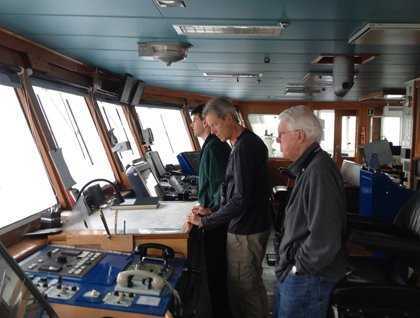Despite having all the potential for providing us with “just another day at sea,” 22 November actually delivered a plethora of excitement and education. The day dawned early, before 3:00 a.m., and with heavy seas and heavy cloud. However, within a few hours the sky was lightening, and it was possible to believe in distance patches of blue. Soon prions, those pelagic marine fairies of the bird world were present in good numbers flashing across the bow and easily outnumbering the ever-present pied pintado petrels. The prions, also known as “whale birds” were an omen, presaging the appearance of an extraordinary variety of cetaceans.
During the early hours our night watch and ice-captain Ben had seen a number of spouts, and within minutes of reaching the bridge, first visitors were able to see spouts themselves, almost certainly of the greyhound of the sea, the fin whale, one of the largest rorqual or pleated-throat baleen whales. Soon afterwards a large angled blow indicated that we were approaching a sperm whale, the largest of the toothed whales. As we watched it blew a few more times then upped its flukes and dived for the depths. We continued our course southwards leaving the sperm whale somewhere below and behind us, but very soon afterwards a pod of orca angled in towards the bow. Three cetacean species in under 30 minutes; what a start to the day, and all before breakfast!
Were the increasing numbers of prions appearing a mere coincidence, or was there really something in their alternate name? Either way, within an hour we were spotting many more fin whales, pushing bow waves of water before them and leaving their spouts lingering in the air—the second largest of all the whales. One individual however, was smaller and behaving erratically, then another revealed its dorsal fin and we realised we had a sei whale, the third largest species. Then yet another whale lingered long enough at the surface to reveal its white, right hand jaw and thus confirming our identification of it as a fin whale. So many whales that we lost count, certainly a dozen, were there 15 or 20 in total? To us so many, yet of course back in the hey-day of whaling, 60 and more years ago, these would have been trivial numbers.
Not trivial at all was our next observation, for suddenly, launching itself out of the water just left of our bow was a blue whale, its head, back, colouration and dorsal fin all confirming its identification; the largest of all living mammals. What a morning!
Putting excitement behind us the remainder of our day was an opportunity for further entertainment and continuing education, as we ploughed our way south through heavy seas, with talks by Karen on Penguins of the Antarctica Peninsula, Jason on Antarctic Geology, and Dan and Eric on The Many Faces of Antarctic Ice.







